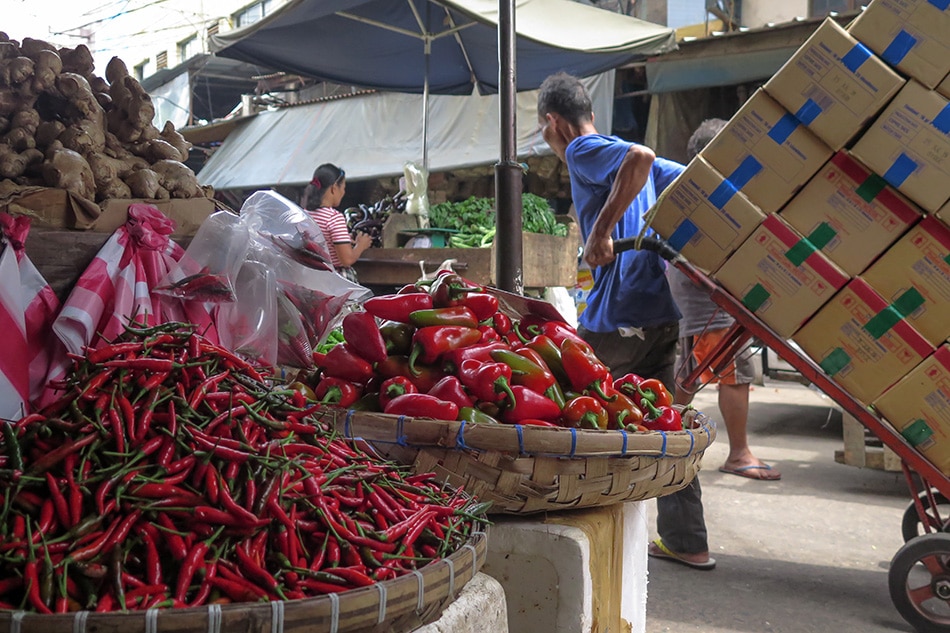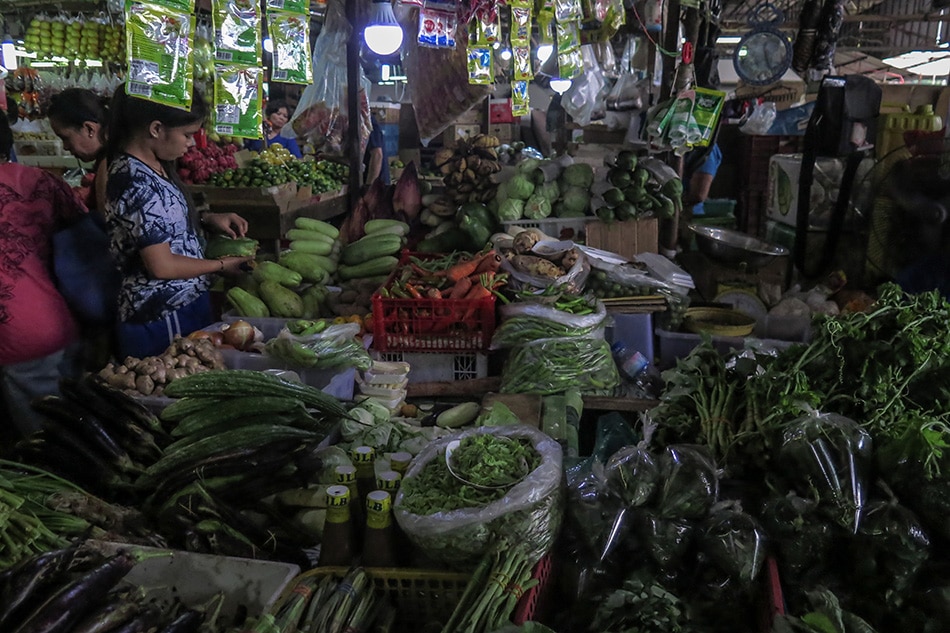Siling labuyo burns wallets as monsoon stokes inflation | ABS-CBN
ADVERTISEMENT

Welcome, Kapamilya! We use cookies to improve your browsing experience. Continuing to use this site means you agree to our use of cookies. Tell me more!
Siling labuyo burns wallets as monsoon stokes inflation
Siling labuyo burns wallets as monsoon stokes inflation
Patrick Quintos,
ABS-CBN News
Published Sep 10, 2018 09:55 AM PHT
|
Updated Sep 10, 2018 11:13 PM PHT
MANILA (UPDATED) -- Consumers looking to spice up their meals with siling labuyo are feeling the heat as the price of one of the world's hottest chilies soared in recent weeks, following monsoon rains that pushed up prices of vegetables across the board.
MANILA (UPDATED) -- Consumers looking to spice up their meals with siling labuyo are feeling the heat as the price of one of the world's hottest chilies soared in recent weeks, following monsoon rains that pushed up prices of vegetables across the board.
When prices peaked to as much as P1,000 per kilo in some Metro Manila wet markets such as in Malabon and Balintawak in Quezon City, bird's eye chilies were nearly 7 times more expensive than chicken and 4 times more expensive than beef. Prices have begun to go down.
When prices peaked to as much as P1,000 per kilo in some Metro Manila wet markets such as in Malabon and Balintawak in Quezon City, bird's eye chilies were nearly 7 times more expensive than chicken and 4 times more expensive than beef. Prices have begun to go down.
Food inflation zoomed to 8.5 percent in August, outpacing the headline rate of 6.4 percent. Both are at their highest in nearly 10 years based on 2012 prices. Vegetable prices alone rose 19.2 percent.
Food inflation zoomed to 8.5 percent in August, outpacing the headline rate of 6.4 percent. Both are at their highest in nearly 10 years based on 2012 prices. Vegetable prices alone rose 19.2 percent.
A seller at the Balintawak market for 2 decades, Lani Palomar, said she had not seen labuyo prices this high, which forced her regular customers to buy less.
A seller at the Balintawak market for 2 decades, Lani Palomar, said she had not seen labuyo prices this high, which forced her regular customers to buy less.
ADVERTISEMENT
"May dalawa o tatlong linggo na 'yan. Nag-umpisa lang 'yan sa P400. Tapos araw-araw tumaas na," she told ABS-CBN News.
"May dalawa o tatlong linggo na 'yan. Nag-umpisa lang 'yan sa P400. Tapos araw-araw tumaas na," she told ABS-CBN News.
(It's been like this for 2 to 3 weeks now. It started at P400, then it increased almost daily.)
(It's been like this for 2 to 3 weeks now. It started at P400, then it increased almost daily.)
Metro Manila sources 80 percent of its vegetables from Benguet province and the northwest uplands, which bore the brunt of monsoon rains in the past months, said Junibert de Sagun chief administrative officer at the Department of Agriculture.
Metro Manila sources 80 percent of its vegetables from Benguet province and the northwest uplands, which bore the brunt of monsoon rains in the past months, said Junibert de Sagun chief administrative officer at the Department of Agriculture.
"Historically, hindi talaga magkatugma 'yung two months water at vegetables (Historically, two months of water and vegetables don't mix)," he said.
"Historically, hindi talaga magkatugma 'yung two months water at vegetables (Historically, two months of water and vegetables don't mix)," he said.
Agriculture damage in Benguet was estimated at nearly P45 million, where a state of calamity was declared on Sept. 4, said Benguet Governor Crescencio Pacalso.
Agriculture damage in Benguet was estimated at nearly P45 million, where a state of calamity was declared on Sept. 4, said Benguet Governor Crescencio Pacalso.
ADVERTISEMENT
Vegetable prices in Metro Manila should go down in September with 40 to 60 tons of vegetables set for delivery every week, Agriculture Secretary Manny Piñol said.
Vegetable prices in Metro Manila should go down in September with 40 to 60 tons of vegetables set for delivery every week, Agriculture Secretary Manny Piñol said.
President Rodrigo Duterte's economic team has set immediate measures to tame inflation, including the "immediately release" 4.6 million available sacks of state subsidized rice. They are also pushing for tariffs in place of import quotas to bring down the price of the staple.
President Rodrigo Duterte's economic team has set immediate measures to tame inflation, including the "immediately release" 4.6 million available sacks of state subsidized rice. They are also pushing for tariffs in place of import quotas to bring down the price of the staple.
LABUYO FIX
Vegetable vendor Senas Lontoc sells labuyo at P10 for 6 pieces to help consumers get their spice fix.
Vegetable vendor Senas Lontoc sells labuyo at P10 for 6 pieces to help consumers get their spice fix.
"Ngayon lang namin naranasan 'to. Ngayon, bibili-bili na lang kami nang kaunti, pakala-kalahating-kilo para hindi malugi," Lontoc told ABS-CBN News.
"Ngayon lang namin naranasan 'to. Ngayon, bibili-bili na lang kami nang kaunti, pakala-kalahating-kilo para hindi malugi," Lontoc told ABS-CBN News.
(This is the first time we experienced it. We don't buy that much now, maybe half a kilo at a time so we don't get ruined.)
(This is the first time we experienced it. We don't buy that much now, maybe half a kilo at a time so we don't get ruined.)
ADVERTISEMENT
At an eatery a bus ride away from the market, 48-year-old Gina Rocabo said she stopped offering free chilies, which her regulars grind into soy sauce and fish sauce. She also reduced chili in her dinuguan or blood stew.
At an eatery a bus ride away from the market, 48-year-old Gina Rocabo said she stopped offering free chilies, which her regulars grind into soy sauce and fish sauce. She also reduced chili in her dinuguan or blood stew.
"Sa 18 years ng karinderya ko, ngayon lang nangayari ito. Sobrang mahal ng sili kaya hindi na kami nagbibigay," she said.
"Sa 18 years ng karinderya ko, ngayon lang nangayari ito. Sobrang mahal ng sili kaya hindi na kami nagbibigay," she said.
(In my 18 years of running a carinderia, this is the first time this happened. Chili is so expensive, I can't give it away for free.)
(In my 18 years of running a carinderia, this is the first time this happened. Chili is so expensive, I can't give it away for free.)
At the Balintawak and Divisoria markets, the average price of cabbage increased to around P130 from P50 in recent weeks, sayote rose to P70 from P20, carrots to P140 from P70 and pechay to P130 from P40, vendors said.
At the Balintawak and Divisoria markets, the average price of cabbage increased to around P130 from P50 in recent weeks, sayote rose to P70 from P20, carrots to P140 from P70 and pechay to P130 from P40, vendors said.
Businesswoman Mercedes Lopez tried to haggle with vendor Roland Pacardo to sell her 5 kilos of cabbage for less than P130 a kilo. But Pacardo refused as lowering the price would take away his small profit.
Businesswoman Mercedes Lopez tried to haggle with vendor Roland Pacardo to sell her 5 kilos of cabbage for less than P130 a kilo. But Pacardo refused as lowering the price would take away his small profit.
ADVERTISEMENT
Lopez said she wouldn't be able to send cabbage and sayote to her mother in Quezon province, where they run a small grocery. High fuel prices make transporting the vegetables more expensive, she said.
Lopez said she wouldn't be able to send cabbage and sayote to her mother in Quezon province, where they run a small grocery. High fuel prices make transporting the vegetables more expensive, she said.
"Ang taas talaga ng mga presyo ngayon. Masyadong krisis," she said.
"Ang taas talaga ng mga presyo ngayon. Masyadong krisis," she said.
(Prices are really high. It's a crisis.)
(Prices are really high. It's a crisis.)
-- with a report from Jessica Fenol, ABS-CBN News.
ADVERTISEMENT
ADVERTISEMENT




